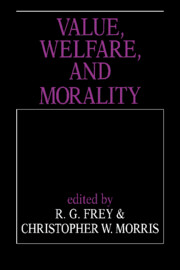Book contents
- Frontmatter
- Contents
- List of contributors
- Preface
- 1 Value, welfare, and morality
- 2 The land of lost content
- 3 Putting rationality in its place
- 4 Can a Humean be moderate?
- 5 Welfare, preference, and rationality
- 6 Preference
- 7 Reason and needs
- 8 Desired desires
- 9 On the winding road from good to right
- 10 Value, reasons, and the sense of justice
- 11 Agent-relativity of value, deontic restraints, and self-ownership
- 12 Agent-relativity – the very idea
- 13 The separateness of persons, distributive norms, and moral theory
- 14 Harmful goods, harmless bads
4 - Can a Humean be moderate?
Published online by Cambridge University Press: 07 December 2009
- Frontmatter
- Contents
- List of contributors
- Preface
- 1 Value, welfare, and morality
- 2 The land of lost content
- 3 Putting rationality in its place
- 4 Can a Humean be moderate?
- 5 Welfare, preference, and rationality
- 6 Preference
- 7 Reason and needs
- 8 Desired desires
- 9 On the winding road from good to right
- 10 Value, reasons, and the sense of justice
- 11 Agent-relativity of value, deontic restraints, and self-ownership
- 12 Agent-relativity – the very idea
- 13 The separateness of persons, distributive norms, and moral theory
- 14 Harmful goods, harmless bads
Summary
Moderate and extreme Humeans
A Humean believes that no preference can be irrational. It is not irrational to prefer the destruction of the world to the scratching of your little finger, or your own acknowledged lesser good to your greater.
An extreme Humean leaves it at that. A moderate Humean adds a qualification. Although, she says, no individual preference can be irrational on its own, some patterns of preferences are irrational; there are some sets of preferences that a person cannot rationally have together. Rationality, then, does constrain preferences to some extent.
Moderate Humeans recognize two types of constraint on preferences. One, recognized by David Hume himself, is the connection between preferences about means and preferences about ends. Suppose an action A will bring about one result, and B will bring about another, and you prefer the result of A to the result of B, and you have no intrinsic preference between A and B. Then it is irrational for you to prefer B to A.
The other type of constraint is consistency. Moderate Humeans recognize various consistency constraints. One is transitivity: If you prefer an alternative A to B and you prefer B to C, then it is irrational for you to prefer C to A. There are other consistency constraints too. Decision theory is generally taken to encapsulate them. Decision theory consists of a number of axioms defined on a person's preferences.
- Type
- Chapter
- Information
- Value, Welfare, and Morality , pp. 51 - 73Publisher: Cambridge University PressPrint publication year: 1993
- 25
- Cited by



